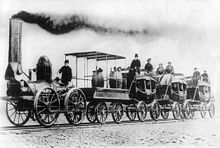
The Mohawk & Hudson Railroad was the first railroad built in the state of New York and one of the first railroads in the United States. It was so-named because it linked the Mohawk River at Schenectady with the Hudson River at Albany. It was conceived as a means of allowing Erie Canal passengers to quickly bypass the circuitous Cohoes Falls via steam powered trains.
The railroad was incorporated on April 17, 1826, as the Mohawk & Hudson Company and opened for public service on August 9, 1831. On April 19, 1847, the company name was changed to the Albany & Schenectady Railroad. The railroad was consolidated into the New York Central Railroad on May 17, 1853.
History
On December 28, 1825, Schenectady County resident (Duanesburg) George William Featherstonhaugh (pronounced Fenshaw) ran a newspaper notice announcing the formation of the Mohawk & Hudson Rail Road Company. The intention was to bypass the Erie Canal between Albany and Schenectady, cutting time for the trip from a whole day to under one hour. The Mohawk & Hudson became the first chartered railroad in New York State on April 17, 1826.
Construction began in August 1830 and the railroad opened September 24, 1831, on a 16-mile route between Albany and Schenectady through the Pine Bush region that separates both cities. The civil engineer Peter Fleming surveyed the right-of-way and provided the cost estimates. Fleming resigned in 1830 and was replaced by John B. Jervis. The tracks were made of strap rail resting on stone blocks rather than crossties that later became standard. Initially the line ended outside the two cities to avoid steep grades — in Albany the line ended near the current intersection of Madison and Western Avenues — and the passengers covered the remaining distance in stagecoaches. Later at each end an inclined plane with a fixed steam engine was used to raise and lower the train.

The DeWitt Clinton locomotive, built by the West Point Foundry in New York, made its first test run on July 2, 1831. After some hesitation it was decided that the engine would burn wood rather than coal. The official opening took place on September 24, 1831, with approximately eighty politicians and dignitaries. The DeWitt Clinton, pulling three cars, covered the route in forty-seven minutes. Another eight cars had to be pulled by horses.
In 1832, a rider wrote in his journal.
June 28, arrive in Schenectady. Among the astonishing inventions of man, surely that of the locomotive steam engine hath no secondary rank. By this matchless exercise of skill, we fly with a smooth and even course along once impassible barriers, the valleys are filled, the mountains laid low, and distance seems annihilated. I took my seat as near as possible to the car containing the engine, in order to examine more minutely the operation of this, to me, novel and stupendous specimen of human skill. Having thus, as if by some invisible agency flown the distance of 16 miles in 40 minutes, at Schenectady I took passage on the Hudson and Erie Canal for Buffalo.
References
- Christopher T. Baer, Pennsylvania RR Chronology, Sunday, January 20, 2013, A GENERAL CHRONOLOGY OF THE PENNSYLVANIA RAILROAD COMPANY PREDECESSORS AND SUCCESSORS AND ITS HISTORICAL CONTEXT © 2004-2011 Pennsylvania Technical and Historical Society p.5
- List of names in English with counterintuitive pronunciations
- ^ Starr, Timothy (2011). Early Railroads of New York's Capital District. T. Starr. ISBN 978-0-578-08097-0.
- Rittner, Don. "American Railroading Began Here". Retrieved Dec 11, 2013.
- Monroe, Henry (1914). Schenectady Ancient and Modern.
- Journal of Ebenezer Mattoon Chamberlain, Indiana Magazine of History, Vol XV, September 1919, p. 241.
External links
| New York Central Railroad subsidiaries | |
|---|---|
| 1850s | |
| 1860s |
|
| 1870s |
|
| 1880s |
|
| 1890s |
|
| 1900s |
|
- Defunct New York (state) railroads
- Predecessors of the New York Central Railroad
- Erie Canal
- Schenectady, New York
- Railway companies established in 1847
- Railway companies disestablished in 1853
- Transportation in Albany, New York
- History of Albany, New York
- 1826 establishments in New York (state)
- Transportation in Albany County, New York
- American companies disestablished in 1853
- American companies established in 1847
